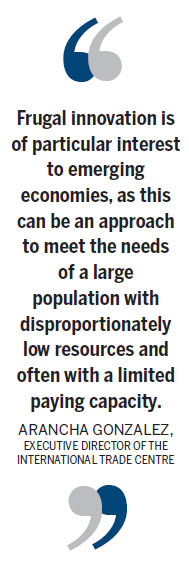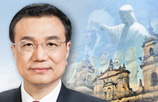Shoestring innovation gives more for less
Updated: 2015-06-12 06:37
By Krishna Kumar Vr(China Daily Europe)
|
|||||||||||
Inventors in Asia are coming up with frugal ideas that benefit society and help economies grow
The number of frugal products and processes in Asia has grown rapidly recently, and emerging markets such as China are proving to be a breeding ground for new ideas.
"Frugal innovation is of particular interest to emerging economies, as this can be an approach to meet the needs of a large population with disproportionately low resources and often with a limited paying capacity," says Arancha Gonzalez, executive director of the International Trade Centre, a joint agency of the United Nations Conference on Trade and Development and the World Trade Organization.
|
An electric car manufactured by Chinese carmaker BYD is launched in Manila. The company has radically reduced the cost of lithium-ion batteries by using cheaper raw materials and changing the manufacturing process. AFP |
For example, the Chinese smartphone vendor Xiaomi made a name for itself by selling high-end devices for around one third of the price of Apple products.
Xiaomi's business model, which eschews the financial burden of using traditional marketing and distribution practices and relies on the Internet to fuel sales, has made the company the richest startup firm in terms of valuation.
"It's an approach that turns constraints into advantages, or scarcity into opportunity," says Kirsten Bound, head of international innovation at the research firm Nesta of London.
"It's about getting more from less for more people. Frugal innovation isn't just about creating a lower cost, lower spec or no-frills version of a product or service. It describes an approach to innovation that seeks to greatly reduce costs by 100 or 1,000 times while maintaining quality and performance."
BYD, the Chinese manufacturer of cars and rechargeable batteries, has radically reduced the price of lithium-ion batteries by using less costly raw materials and producing them at ambient temperatures rather than in expensively heated dry rooms.
This has reduced their price from about $40 (36 euros) to $12 and made the batteries competitive with less-powerful nickel-cadmium batteries. Today BYD is the world's largest producer of batteries and has a 25 percent market share in cell phone batteries.
Mindray, a maker of medical devices in China, focuses on second- and third-tier hospitals and clinics in smaller towns. By doing so it has been able to undercut the global majors in the industry such as Siemens, Philips and Toshiba and build a strong business by selling comparable equipment at much lower prices.
In India, Arunachalam Muruganantham is credited with starting a revolution in making and using sanitary products.
In 1998, Muruganantham, then a laborer in a small town in the state of Tamil Nadu, designed a simple low-cost machine to produce cheap sanitary pads for his wife.
The 53-year-old school dropout is now a globally acclaimed frugal innovator and motivational speaker. His invention also secured him a space in Time magazine's 100 most influential people in the world last year, alongside Chinese President Xi Jinping, US President Barack Obama and Tencent founder Pony Ma.
"The world needs frugal solutions," Muruganantham says. "It is definitely possible to provide affordable solutions to all the world's problems by innovating."

His startup, Jayaashree Industries, now competes with top global brands. Low-cost machines made by his company have been installed across India and are available in seven other countries. Most of his customer base comes from the 65 percent of households in India that earn less than $1 a day.
Frugal innovation means doing more and better with less, says Jaideep Prabhu, a professor at Judge Business School at the University of Cambridge.
"It is all about finding new ways to create more value for consumers, shareholders and society while reducing the use of resources - whether they are financial or natural resources or time."
Amitava Chattopadhyay, a professor of marketing at Insead Business School, said in an article in The Economic Times newspaper in India: "The willingness to experiment with new ideas and learn from them is a hallmark of many Chinese companies."
However, frugal innovation is not just about encouraging growth. Bound at Nesta says it is the social element that makes it so interesting.
"That's not to say it doesn't have commercial objectives and commercial value. Reaching out to serve rapidly growing and enormous lower-middle-class markets in emerging economies is a smart choice for many companies. However, the most interesting frugal innovations do have remarkable social impacts."
Prabhu points out the importance of the larger social objective of frugal innovation.
"It isn't just about a narrow focus on creating value for shareholders; it's also about making the lives of consumers better and improving things for society more generally. It's also about conserving scarce resources, including time; and this, too, has important social objectives."
Devi Shetty, a cardiac surgeon and philanthropist, leveraged economies of scale to provide affordable healthcare in India by applying innovations from manufacturing into a hospital setting.
His efforts have enabled him to deliver heart operations at a fraction of what they normally cost. The hospital charges an average of $2,000 for open-heart surgery, compared with between $20,000 and $100,000 in the United States. And his hospital still runs at a profit.
Bound says: "Frugal innovations offer radical new ways to solve social problems - from low-cost private school chains to transformational medical diagnostic devices to affordable family cars."
The Indian conglomerate Tata produced the world's cheapest car, the Nano, in 2009, and it became a symbol of frugal innovation when the first one rolled off the production line with a price tag of less than $2,000.
"Frugal is fantastic, and it is for everyone," says Y. S. Rajan, a former research scientist at the Indian Space Research Organisation.
"A cheap system doesn't mean an incompetent system. I would place Mumbai's dabbawalas as a classic case of a frugal delivery system on a massive scale."
Known for their steadfast delivery of freshly made lunches, these dabbawalas navigate Mumbai's maze every day using a complex code to sort through and deliver thousands of lunchboxes (dabba in Hindi) from people's homes to the desks of office workers and then back home again.
They have been doing this for more than a century, and their efficiency was the focus of a Harvard Business School case study titled The Dabbawala System: On-Time Delivery Every Time.
No logistics company has been able to replicate this innovative and inexpensive system, Rajan says.
Cultivating an innovative culture is a challenge for large companies everywhere. This is partly because bigger businesses are often viewed by employees as slow-moving and bureaucratic, and therefore not an ideal fit for budding entrepreneurs.
"Changing a deeply ingrained mindset and culture, and changing well-established processes and ways of doing business is not easy," Prabhu says.
"Large companies have typically followed a highly structured approach to innovation, which is expensive, technology-driven and time- and resource-consuming. These companies, being large and successful, also find it hard to change, especially when this change requires breaking down well-established silos, chains of command and reporting lines.
"Many of these companies do have resources, so for them to think about doing more for less could go against the grain."
So what tends to happen is that the big businesses acquire smaller, more nimble companies or figure out ways to partner with them. Some companies take a dual approach, innovating internally while also acquiring companies that can deliver the necessary skills and technology to maintain a competitive position.
"Many smart companies recognize their limitations - that they cannot replicate the startup culture," says Raman Chitkara, global leader of the technology practice at PricewaterhouseCoopers.
"Therefore, they often look to obtain the innovation through acquisitions, which means they are paying a premium price versus if they had done the innovation organically. But they are fine with paying the premium because the technology has already been developed."
However, not all innovations are up for grabs. Muruganantham says he never intends to sell his startup and his patented products to a multinational company or a private investor.
"Frugal innovation by startups should challenge big companies to innovate and sell cheaper products," he says.
(China Daily European Weekly 06/12/2015 page8)
Today's Top News
Zhou Yongkang sentenced to life in prison
Kiev announces new round of peace talks on Ukraine crisis
Greece, EU powers agree to step up debt talks as crunch looms
EU sanctions hamper Italian-Russian commercial ties: Putin
Suu Kyi begins groundbreaking visit
G7 'ignore the facts over South China Sea'
British PM hails 'golden year' in UK-China relations
China's new rail giant bags first overseas deal from India
Hot Topics
Lunar probe , China growth forecasts, Emission rules get tougher, China seen through 'colored lens', International board,
Editor's Picks

|

|

|

|

|

|







